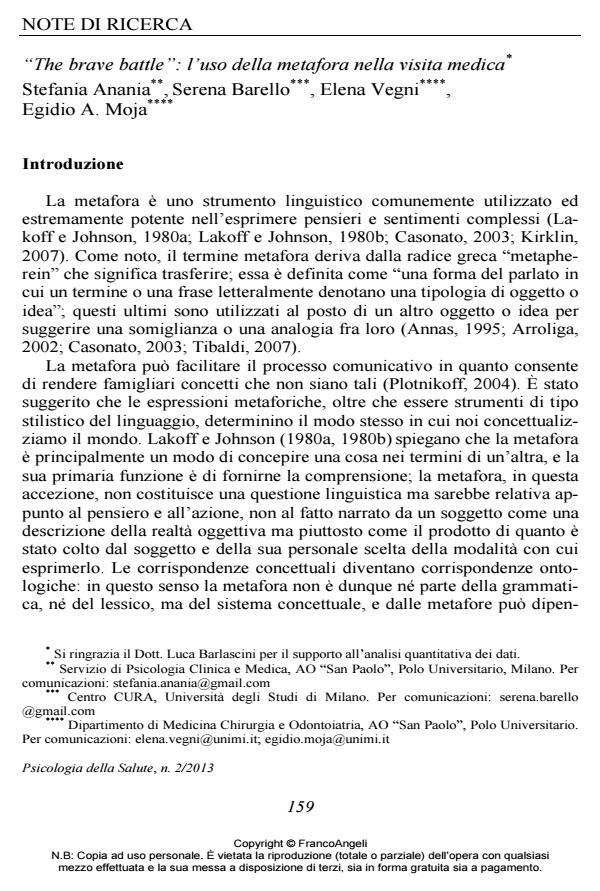"The brave battle": the use of metaphors in medical consultation
Journal title PSICOLOGIA DELLA SALUTE
Author/s Stefania Anania, Serena Barello, Elena Vegni, Egidio A. Moja
Publishing Year 2013 Issue 2013/2 Language Italian
Pages 14 P. 159-172 File size 449 KB
DOI 10.3280/PDS2013-002010
DOI is like a bar code for intellectual property: to have more infomation
click here
Below, you can see the article first page
If you want to buy this article in PDF format, you can do it, following the instructions to buy download credits

FrancoAngeli is member of Publishers International Linking Association, Inc (PILA), a not-for-profit association which run the CrossRef service enabling links to and from online scholarly content.
There are not systematic researches about the use of metaphors in medical consultations. This work aimed to describe the use of metaphors in Italian general medicine consultations through the analysis of: the frequencies of metaphors, metaphors’ trigger, metaphors’ distribution on timing, what metaphors say, how metaphors explain their contents, the functions of the metaphors (cognitive function vs emotive function). 100 videotaped general practice outpatient consultations were considered. All the sentences where metaphors used a figurative language in which one concept is described as being equivalent to another were selected and transcribed. Data analysis was conducted using a quantitative approach (frequencies) to analyze metaphors’ trigger and timing, and a qualitative analysis was conducted first to categorize metaphors and then to create a taxonomy based on the metaphors’ categories. 280 metaphors were found: 43.2% were pronounced by physicians and 56.8% by patients. In 41 consultations the trigger was the patient (55.4%). Metaphors were pronounced on the average every 3’30’’. The taxonomy emerged overlapped partially with the existent literature. Patients used metaphors more than physicians, gathering them in the first part of the consultation, and using them with emotional goals. Metaphor is a specific linguistic feature of the physician-patient relation.
Keywords: Metaphor, ambulatory care, general practice, physician-patient communication
- Annas G.J. (1995). Reframing the debate on health care reform by replacing our metaphors. New England Journal of Medicine, 332: 744-7.
- Arroliga A.C. (2002). Metaphorical medicine: using metaphors to enhance communication with patients who have pulmonary disease. Annals of Internal Medicine, 137 (5): 376-380.
- Carter A.H. (1989). Metaphors in the physician – patient relationship. Soundings, 72(1): 153-64.
- Casarett D., Pickard A., Fishman J.M., Alexander S.C., Arnold R.M. Pollak K.I. et al. (2010). Can metaphors and analogies improve communication with seriously ill patients?. Journal of Palliative Medicine, 13(3): 255-60. DOI: 10.1089/jpm.2009.022
- Casonato M. (2003). Immaginazione e metafora [Imagination and metaphor]. Bari: Ed. Laterza.
- Coulehan J. (2003). Metaphor and medicine: narrative in clinical practice. Yale Journal of Biology and Medicine, 76: 87-95.
- Gibbs R.W.J. (2006). Metaphor interpretation as embodied simulation. Mind&Language, 21 (3): 434-58.
- Gibbs R.W.J. and Franks H. (2002). Embodied metaphor in women’s narratives about their experiences with cancer. Health Communication, 14(2): 139-65. DOI: 10.1207/S15327027HC1402_
- Hanne M. and Hawken S.J. (2007). Metaphors for illness in contemporary media. Medicine Humanities, 33: 93-9.
- Hodgkin P. (1985). Medicine is war: and other medical metaphors. British Medical Journal, 291: 1820-1. DOI: 10.1136/bmj.291.6511.182
- Kirklin D. (2007). Truth telling, autonomy and the role of metaphor. Journal of Medical Ethics, 33: 11-4. DOI: 10.1136/jme.2005.01499
- Kirmayer L.J. (2004). The cultural diversity of healing: meaning, metaphor and mechanism. British Medical Bulletin, 69: 33-48. DOI: 10.1093/BMB/Idh00
- Kövecses Z. (1990). Emotion Concepts. New York: Springer-Verlag.
- Lakoff G. and Johnson M. (1980a). Conceptual metaphor in everyday language. Journal of Philosophy, 77(8): 453-86.
- Lakoff G. and Johnson M. (1980b). The metaphor we live by. Chicago: Chicago University Press.
- Mabeck C.E. and Olesen F. (1997). Metaphorically transmitted diseases. How do patients embody medical explanations. Family Practice, 14: 271-8. DOI: 10.1093/fampra/14.4.27
- Moja E.A., Colombari S., Mariani V., Ferrari S., Gradi E.C., Lunardelli M. et al. (2005). L’archivio di videoregistrazioni di consultazioni cliniche dell’Università degli Studi di Milano [Videotape records of clinic consultations of the Milan University]. Cura: rivista di comunicazione e relazione in medicina, 1(1): 35-40.
- Mustacchi P. and Krevans J.R. (2001). Metaphorically speaking. The metaphor of health care provision as a factory. The Western Journal of Medicine, 175 (1): 12-3. DOI: 10.1136/ewjm.175.1.1
- Penson R.T., Schapira L., Daniels K.J., Chabner B.A., Lynch T.J.J. (2004). Cancer as metaphor. Oncologist, 9: 708-16. DOI: 10.1634/theoncologist.9-6-708PeriyakoilV.(2008).Usingmetaphorsinmedicine.JournalofPalliativeMedicine,11(6):842-4.DOI:10/1089/jpm.2008.988
- Pickering N. (1999). Metaphors and models in medicine. Theoretical Medicine and Bioethics, 20: 361-75. DOI: 10.1023/A:100540341172
- Pijnenborg R., Vercruysse L. and Hanssens M. (2008). Fetal-maternal conflict, trophoblast invasion, preeclampsia, and the Red Queen. Hypertension and Pregnancy, 27: 183-96. DOI: 10.1080/1064195070182671
- Plotnikoff G.A. (2004). Metaphors: words as bridges and barriers to effective medical communication. Minnesota Medicine, 87(7): 42-5.
- Reisfield G.M., Wilson G.R. (2004). Use of metaphor in the discourse of cancer. Journal of Clinical Oncology, 22(19): 4024-7. DOI: 10.1200/JCO.2004.03.13
- Rosenman S. (2008). Metaphor in clinical practice. Australian Family Physician, 37: 865.
- Segal J.Z. (1997). Public discourse and public policy: some ways that metaphor constrains health (care). Journal of Medical Humanities, 18(4): 217-31. DOI: 10.1023/A:102564590410
- Skelton J.R., Wearn A.M., Hobbs F.D.R. (2002). A concordance–based study of metaphoric expressions used by general practitioners and patients in consultation. British Journal of General Practice, 52(475): 114-8.
- Skott C. (2002). Expressive metaphors in cancer narratives. Cancer Nursing, 25 (3): 203-35.
- Sontag S. (1989). L’AIDS e le sue metafore [AIDS and Its Metaphors]. Torino: ed. Einaudi.
- Tibaldi G. (2007). Menopausa, immagini e metafore, simboli e prospettive [Menopause, images and metaphors, symbols and perspectives]. In: Casadei D. e Righetti P.L., a cura di, L’intervento psicologico in ginecologia [Psychological consultation in gynaecologic unit]. Roma: Edizioni Magi, pp. 189-204.
- Zimmermann J. (2003). Cleaning up the river: a metaphor for functional digestive disorders. American Journal of Clinical Hypnosis, 45(4): 353-9.
- Interpersonal Argumentation in Educational and Professional Contexts Francesca Alby, Marilena Fatigante, Cristina Zucchermaglio, pp.183 (ISBN:978-3-319-59083-7)
Stefania Anania, Serena Barello, Elena Vegni, Egidio A. Moja, "The brave battle": l’uso della metafora nella visita medica in "PSICOLOGIA DELLA SALUTE" 2/2013, pp 159-172, DOI: 10.3280/PDS2013-002010